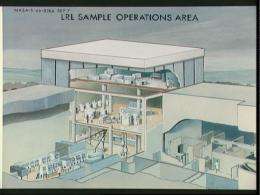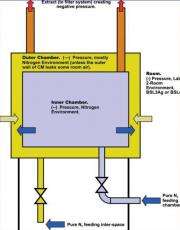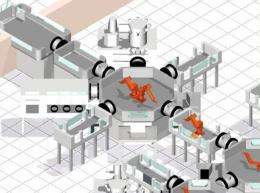Keeping Mars Contained

When robotic spacecraft bring a sample of Mars back to Earth, scientists will need specially-designed facilities to study the samples and prevent them from escaping to the outside world.
A returning spacecraft may someday hurtle through Earth's atmosphere bearing evidence of life from Mars. But scientists won't casually crack open the precious payload in any old laboratory. They will need a specially-designed building that not only protects the Martian samples from terrestrial contamination, but also prevents any Martian material or organisms from escaping into Earth's biosphere.
Such a Mars sample return mission could signal a huge scientific coup for understanding the red planet's ability to harbor life, and so NASA launched the initial phases of a sample return mission in the late 1990s. Programmatic considerations, including technical and budgetary concerns, killed the mission planning early on, but the U.S. space agency continued to study what type of sample return facility (SRF) might become necessary for such a mission.
Now NASA's Mars team has released the results of that study. Three architectural firms drew up plans for how humans and robots could handle extraterrestrial samples within special facilities.
"We could build a facility today that would meet relevant standards for biocontainment (to protect the environment) and we could build a facility today that would meet scientific needs for contamination control (to protect the samples)," said Deborah Bass, a scientist with NASA's Mars Exploration Program. "Our technological challenges arise from the need to do both at the same time!"
Bass collaborated on the analysis of the facility designs with Karen Buxbaum, NASA's planetary protection manager for the Mars Program, and other NASA colleagues and planners. Their assessment of the three design submissions was detailed in October's issue of the journal Astrobiology.
Not your father's moon samples
A Mars sample return mission won't mark the first time that spacefarers have brought back extraterrestrial samples. Apollo astronauts who walked on the lunar surface returned with hundreds of pounds of moon rocks, and NASA built the Lunar Receiving Laboratory to quarantine the lot.
But Bass and Buxbaum point out several differences between that case and a future Mars sample return mission. A Mars mission would return just over 1 pound (0.5 kg) of samples, as opposed to the hundreds of pounds of lunar regolith, and so any future facility's tests must use as little of the precious Martian samples as possible.
A Mars SRF would also require much less space than the Lunar Receiving Laboratory, because there won't be any returning astronauts from Mars who require quarantine.

Requirements linked to scientific understanding have similarly changed since the first Moon landing. NASA initially tried plant growth experiments in the lunar regolith samples, but no scientist today would bother with similar Martian soil experiments because of the lack of viability for plants. And that's assuming there would be enough soil in the Martian sample to conduct such tests.
Researchers also first assumed that animal testing would become necessary for biohazard experiments involving Mars samples. But advances in biological analysis have opened up the possibility that scientists could run smaller tests that don't require animals.
Finally, scientists and policymakers want to take more cautionary steps to protect Earth against any possibility that Mars microbes or other contaminants could escape the lab.
"We know more about remarkable abilities of terrestrial microbes to survive (sometimes thrive) in challenging environmental conditions," Bass and Buxbaum noted. "Many more regulations and safeguards are now in place that must be observed to ensure a successful sample return program."
Competing visions for humans and robots
NASA hired three architectural design teams to design a facility with containment equivalent to the Biosafety Level 4 labs, which typically house samples of highly infectious diseases.
One facility design by Industrial Design and Construction (IDC) featured a mostly human workforce. Another design by Lord, Aeck, Sargent (LAS) took the opposite approach by creating a fully robotic facility, based on the idea that robots would help eliminate human error.
A third design by Flad & Associates (FLAD) took a middle approach by having humans assisted by robots.
Robot advocates consider humans the "weak link" in the chain, and argue that human operators also represent a big source of possible contamination for the Mars samples. But other researchers counter that human operators would add a special interactive and adaptive touch that current robots lack.
Several of the facility designs also call for double-walled biosafety cabinets, which use air pressure to keep any contaminant leaks contained within the double-wall design. That future technology may help keep any hazardous Mars materials inside the cabinets, and also keep out unwanted Earth material that could contaminate scientific testing.

Moving closer to Mars sample return
Based on the three design proposals, NASA planners and researchers said that a sample return facility would likely require 20 to 30 permanent staff members and cost $121 million, not including an annual operational cost of $7 million.
NASA has again begun quietly discussing the possibility of a future sample return mission. But such a venture would not represent a stand-alone mission -- the U.S. space agency wants to work up to a sample return in several mission stages.
"The first definitive step, which would be a rover to collect and cache the samples, is under consideration for launch in 2018," Bass and Buxbaum explained. Whether such a mission will get approved remains uncertain, but people eager for a new glimpse of extraterrestrial soil could see their wishes fulfilled as early as the 2020s.
Source: Astrobio.net, by Jeremy Hsu



















